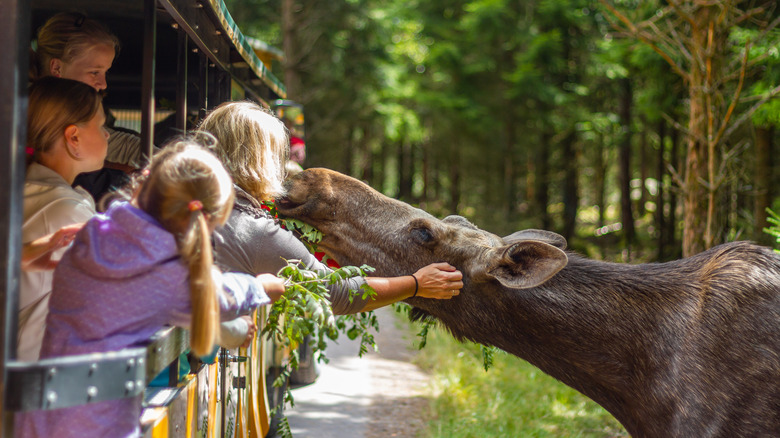One Swedish Farm Produces A Rare Moose Milk Cheese, But At A Cost
Cheese is an internationally-beloved dairy product featured in countless recipes. It can be a snack, topping, sauce component, or dip. Depending on the type, it can be sliced, grated, crumbled, melted, fried, or grilled — you name it. Cheese is a crucial element of an exemplary charcuterie board, a popular protein in vegetarian dishes like palak paneer, and a good, filling source of calcium, protein, and vitamins A and B12 (per Harvard School of Public Health).
Cheese is most commonly made from bovine (cow's) milk but can also be made from sheep, goats, buffalo, deer, llamas, and many others (per CNN). In Russia and Sweden, moose cheese is a thing — though moose may be referred to as elk there, which are different than North American elk, Britannica says. It's the most expensive cheese behind the donkey milk cheese Pule (per Insider) for very special reasons, produced by a very special farm.
The sole home of moose cheese
The only place in the world that makes moose milk cheese is Älgens Hus (Elk House) in Bjurholm, Sweden, according to Cheese.com. There are three milked moose: Gullan, Haelga, and Juno says Q97.9. The cheese can only be obtained at the Elk House's restaurant and a handful of shops nearby, adds Culture Cheese Magazine. Culture also reports that the three sisters at Elk House craft four varieties of moose milk cheese: white mold, creamy blue, dried blue, and feta, with the latter being the most popular (per Cheese.com). It has an acidic tang and is stored in vegetable oil.
According to Culture, moose produce limited amounts of milk daily, lactating only in a five-month window and requiring extensive time to destress after milking. Sessions can take a while and must be done in seclusion, per Q97.9. It's also worth noting that moose can reach up to 1,300 pounds, stand seven feet tall at the shoulder, and have been known to be aggressive and even deadly (per Britannica). Culture explains that moose milking requires an even temperament and expertise.
More on moose milk
Since Elk House is listed as temporarily closed as of January 2023, you'll be hard-pressed to find moose cheese for your culinary adventures. You're more likely to encounter moose milk: Modern Farmer reports that the fatty, nutritious stuff contains compounds used to treat digestive problems in northern Europe and Russia. It's sourced from remote Kostroma Moose Farm, which supplies the longstanding Ivan Susanin Sanatorium, specializing in gastrointestinal issues.
For those fortunate enough to try it, moose cheese is described as having a "smooth, deep and broad taste, without a sharp and strange aftertaste" (per Q97.9 via Elk House). Modern Farmer describes it as having a coniferous tree aroma, totally on-brand for the massive, majestic animal of the boreal climate. Treat yourself to a nice high-end artisan cheese, perhaps something with a booze-washed rind as a consolation prize. Or consider a Moose Milk cocktail: it'll be cheaper and easier than flying abroad and certainly easier than milking a moose.


